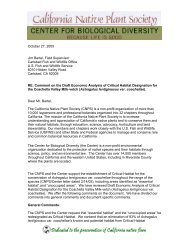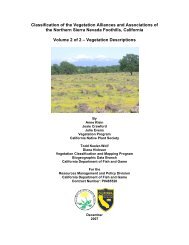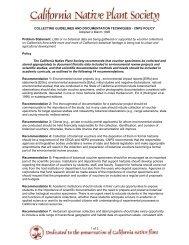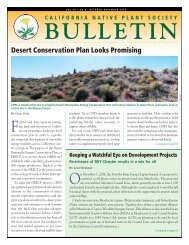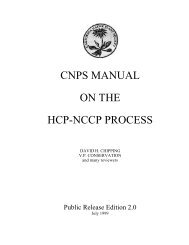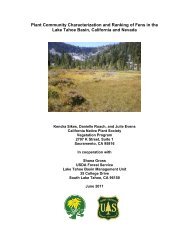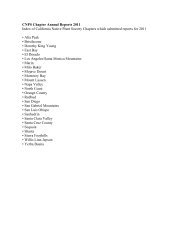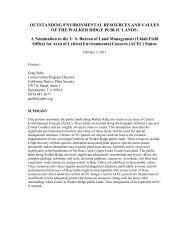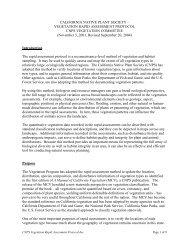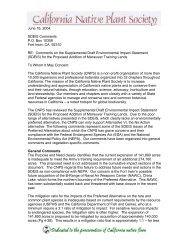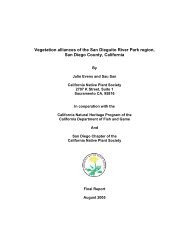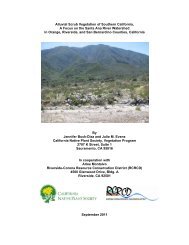Logo Manual - California Native Plant Society
Logo Manual - California Native Plant Society
Logo Manual - California Native Plant Society
Create successful ePaper yourself
Turn your PDF publications into a flip-book with our unique Google optimized e-Paper software.
<strong>California</strong> <strong>Native</strong> <strong>Plant</strong> <strong>Society</strong> <strong>Logo</strong> Guide<br />
Version 2 – May 2011<br />
I. Introduction<br />
This guide details the logo and related visual elements that support the <strong>California</strong> <strong>Native</strong> <strong>Plant</strong><br />
<strong>Society</strong> (CNPS) brand. It also explains how, when used correctly and consistently, these<br />
elements speak for CNPS in an articulate and compelling way.<br />
By following this guide, you help define CNPS for our donors, partners, supporters and the<br />
general public. Equally important, you help them recognize, differentiate, and remember us.<br />
In some cases, this guide provides explicit rules on how to use—and how not to use—various<br />
elements. But overall, it offers a framework for making and evaluating creative decisions. If you<br />
have questions about how to use any brand elements, or need additional information, contact<br />
Tara Hansen, Executive Director, at (916) 447-2677 ext 201 or thansen@cnps.org.<br />
II. History<br />
The mission of CNPS is to conserve <strong>California</strong> native plants and their natural habitats, and<br />
increase understanding, appreciation, and horticultural use of native plants. Since 1965, CNPS<br />
has worked hard to protect <strong>California</strong>'s native plant heritage and preserve it for future<br />
generations.<br />
The original CNPS logotype, featuring a Panamint Daisy (Enceliopsis<br />
covillei) enclosed in a circle with the organization name arching around<br />
within the circle, was designed in the late 1960s by Joyce Burr and used until<br />
April 2011, when the current logo was approved to replace it.<br />
The current logo was developed with the intention of improving and updating<br />
the original daisy logo. While the use of the original flower shape suggests that native plants are<br />
at the heart of the vision of CNPS, the new logo is suited to a modern organization built on a<br />
strong foundation and willing to adapt to advances in communication and technology.<br />
III.<br />
Acknowledgements<br />
CNPS would like to acknowledge the contributions of the Marketing Committee, a volunteer<br />
committee of marketing, communications, and outreach specialists who helped identify the<br />
objectives of the project, and the Brand Development Committee, a committee of staff and<br />
volunteer stakeholders that helped the <strong>Society</strong> evaluate and understand how an updated logo<br />
design could better accommodate modern media applications and increase recognition<br />
opportunities with our public audience. Special thanks also to designer Mark Naftzger for his<br />
extraordinary patience and design expertise, and Marketing consultant William Wayland for<br />
bringing his extensive brand marketing experience to CNPS in this and numerous other public<br />
relations projects.<br />
CNPS <strong>Logo</strong> Guide 1 / 5 Version 2.1 – September 2011
Marketing Committee:<br />
• William Wayland, Marin Chapter<br />
• Mike Ross, Santa Clara Valley Chapter<br />
• Sandy McCoy, East Bay Chapter<br />
• Bob Hass, Editor of The Bulletin and Fremontia<br />
• Arvind Kumar, CNPS Board President, Santa Clara Valley Chapter<br />
• Carol Witham, CNPS Board Vice President, Sacramento Valley Chapter<br />
• Brian LeNeve, CNPS Board Member, Chapter Council Liaison, and Monterey Bay<br />
Chapter<br />
• Brett Hall, CNPS President and Santa Cruz Chapter President<br />
• Tara Hansen, CNPS Executive Director<br />
Brand Development Committee:<br />
• Brian LeNeve, Committee Chair, CNPS Board Member and Chapter Council Liaison<br />
• Sarah Jayne, CNPS Board Secretary and Orange County Chapter Member<br />
• Arvind Kumar, Board Member and Santa Clara Valley Chapter Member<br />
• Marty Foltyn, Chapter Council Secretary and San Diego Chapter Member<br />
• Hazel Gordon, Sacramento Valley Chapter Delegate<br />
• Tara Hansen, CNPS Executive Director<br />
• Josie Crawford, CNPS Education Program Director<br />
• Steve Hartman, LA/Santa Monica Mountains Chapter Member (served partial term)<br />
• Bill Hunt, East Bay Chapter Delegate (served partial term).<br />
IV. <strong>Logo</strong> Usage<br />
Preferred:<br />
One-color:<br />
CNPS <strong>Logo</strong> Guide 2 / 5 Version 2.1 – September 2011
Reverse:<br />
Clear Space: the exclusion zone<br />
The logotype must be reproduced with a clear area around it which is free from other graphic<br />
elements and text. This area is known as the ‘exclusion zone’ and is equal to double the height of<br />
the ‘C’ in <strong>California</strong>.<br />
<strong>Logo</strong> files made available for typical use in desktop and web publishing (jpg, png, and gif<br />
formats) shall include the appropriate exclusion zone as a white or transparent margin. These<br />
graphics are not to be cropped, but may be scaled to meet needs of specific materials and also<br />
retain appropriate clear space.<br />
For larger-format printed materials (banners, large posters, etc) that feature the logo prominently,<br />
the minimum allowable clear space from the edge of the printed piece is equal to the height of a<br />
single ‘C’ in <strong>California</strong>. However, the minimum exclusion zone for any other graphic elements<br />
in these larger pieces is equal to double the height of the ‘C’ in <strong>California</strong>.<br />
CNPS <strong>Logo</strong> Guide 3 / 5 Version 2.1 – September 2011
Minimum Size:<br />
The logo should always be clearly legible.<br />
“Background” Color:<br />
The preferred background or surrounding color for the logotype is white. Where possible, the<br />
background color should be light enough that the logo is visually the most prominent element.<br />
Do not:<br />
• Use the logo in any color other than the preferred color, black, or white (reverse).<br />
• Use any artistic filters on the logo, such as embossing or drop-shadow.<br />
• Stretch, rotate, or distort the logo.<br />
V. Use of <strong>Logo</strong> Mark without Title<br />
In some cases, it may be preferable to use the flower mark only, without the inclusion of the text<br />
title. When the flower mark is used without the title, the minimum clear space (area free from<br />
other graphic elements and text) shall be equal to one-third of the total height of the logo mark.<br />
Preferred<br />
One-color<br />
Clear-space<br />
CNPS <strong>Logo</strong> Guide 4 / 5 Version 2.1 – September 2011
For larger-format printed materials (banners, large posters, etc) that feature the logo mark<br />
without the title prominently, the minimum allowable clear space from the edge of the printed<br />
piece is equal to the 1/6 the total height of the logo mark. However, the minimum exclusion zone<br />
for any other graphic elements in these larger pieces is equal to 1/3 the height.<br />
VI. Color Palette<br />
VII.<br />
GREEN<br />
PMS 364 C<br />
C73% M9% Y94% K39%<br />
RGB 66, 119, 48<br />
HEX #427730<br />
Chapter Modifiers<br />
YELLOW<br />
(flower petals)<br />
PMS 108 C<br />
C0% M6% Y95% K0%<br />
RGB 252, 217, 0<br />
HEX #FCD900<br />
ORANGE<br />
(center of flower)<br />
PMS 123 C<br />
C0% M21% Y88% K0%<br />
RGB 253, 200, 47<br />
HEX #FDC82F<br />
BROWN<br />
(shading on flower)<br />
PMS 1245 C<br />
C% M% Y% K%<br />
RGB 197, 146, 23<br />
HEX #C59217<br />
Standards for logo use in conjunction with chapter names will be developed in the future.<br />
CNPS <strong>Logo</strong> Guide 5 / 5 Version 2.1 – September 2011



